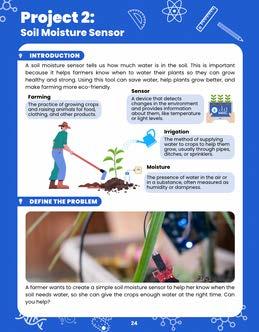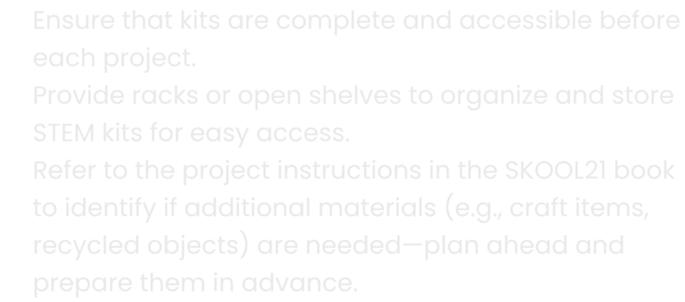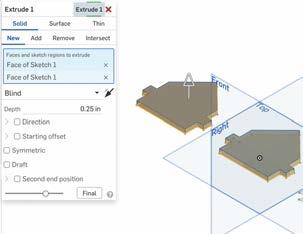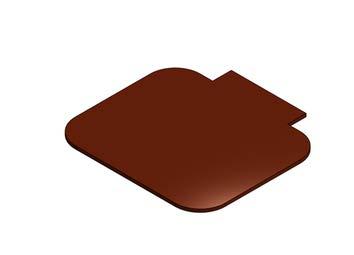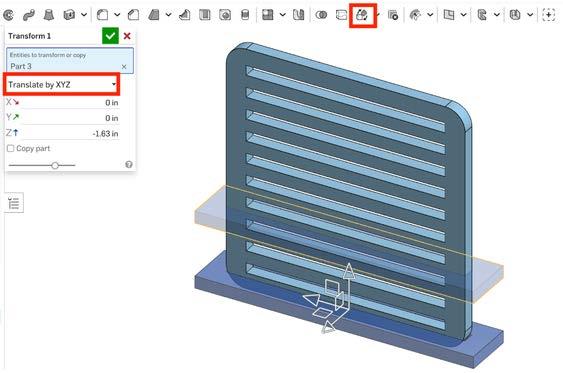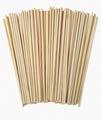TeacherGuide-LaserCuttingLevel12 Teacher Guide
Copyright©2024
Copyright © 20
Author: DanaAlkhatib
Editors: LindseyOwnandErinGoodwin
ISBN: 978-981-17737-6-1
Publishedby:
SKOOL21PTE.LTD.-Singapore
DUOTower,Level8#831
3FraserStreet,189352,Singapore
Allrightsreserved,firstedition2024. Nopartofthisbookmaybereproduced,distributed,ortransmittedinanyformorby anymeans,includingphotocopying,recording,orotherelectronicormechanical methods,withoutthepriorwrittenpermissionofthepublisher,exceptinthecaseof briefquotationsembodiedincriticalreviewsandcertainothernon-commercialuses permittedbycopyrightlaw.
Forpermissionsorinquiries,pleasecontact:
Email: info@skool21.org
Website: https://skool21.org
Preface WelcometotheFutureofTeachingandLearning! Welcome to th
Thank you for joi designed not on meaningful, han young innovato science, technol
BuildingonaStrongFoundation Each level of the
novators series is teachers to lead es, you will guide challenges using creating a strong
Thankyouforjoiningusonthisexcitingjourney!TheSKOOL21STEMInnovatorsseriesis designednotonlytoignitecuriosityinstudentsbutalsotoempowerteacherstolead meaningful,hands-onSTEMlearningexperiences.Throughthisseries,youwillguide younginnovatorsastheyexplore,design,andsolvereal-worldchallengesusing science,technology,engineering,andmathematics(STEM).
EachleveloftheSKOOL21STEMseriesbuildsuponthepreviousone,creatingastrong continuumoflearning—fromsimplemachinestoadvanced3Dmodeling.Students travelthroughkeytechnologicaleras,fromtheIndustrialRevolutiontothe innovationsshapingourfuture.Nomattertheirstartingpoint,everylearnerwill discovernewskillsanddeeperunderstandingalongtheway.
LearningbyDoing AtSKOOL21,webelievestudentslearnbestbydoing.Eachbookcomeswitha comprehensiveSTEMkit,enablingstudentstobuild,test,andexploreconcepts throughhands-onchallenges.Asateacher,youwillfacilitateengagingprojects wherestudentsactivelycreate,problem-solve,andapplycriticalthinkingskills—all whilehavingfun.
MakingaReal-WorldImpact Everyprojectisdesignedtoconnectlearningtoreal-worldissues,inspiredbythe SustainableDevelopmentGoals(SDGs).Throughthesechallenges,studentsseehow theirideascancontributetosolvingproblemslikecleanwateraccess,renewable energy,andenvironmentalconservation—empoweringthemtoenvisionabetter world.
TeachingLikeaPro TheSKOOL21STEMprogramalignswithinternationalstandardsandbestpractices, ensuringthatbothteachersandstudentsaredevelopingthecollaboration, innovation,anddesignthinkingskillsvaluedintoday’sworld.You’renotjust supportingschoolwork—you’repreparingthenextgenerationofthinkers,leaders, andchangemakers.
Building on a not just leaders, and c
IntroductiontotheKit TheSTEMInnovatorsHandbookLevel12isdesignedforstudentswhoare readytoexploreprecisionfabricationanddigitalcraftsmanshipthrough laserengravingandcutting.Buildinguponpriorexperiencewith3Dmodeling andelectronics,thislevelintroduceslearnerstotheworldofadvanced design-to-productionworkflowsusingthelatestindesktopfabrication technology.
AttheheartofthislevelistheCrealityFalcon2Pro22W,ahigh-poweredlaser engraverandcutterbuiltforbothspeedandaccuracy.Withitsindustrialgradelaserandintuitivedesignsoftwarecompatibility,studentscan transformtheirdigitalvectordrawingsintopreciseengravingsorcutsona widerangeofmaterials,fromwoodandacrylictoleatherandmetal.
LessonStructure Eachlessoninthehandbookfollowsastructuredformattoensureclarityand effectiveimplementation.Asamplesolutionisalsofoundattheendofeach lesson.Thestructureincludes:
Lessonobjectives NGSSStandards
CambridgeScienceStandards
ISTEStandardsConnections
CambridgeMathStandards
CommonCoreMathStandards
DefinetheProblem Studentsareintroducedtothescienceconcept andarelatedrealworldproblemtheyaretasked withsolving.
GettingStarted Everyprojectbeginswithguidedfirststeps.This helpsthestudenttoconfidentlytacklethe challengewithasolidfoundation.
DesignandPlan Build-Test-Improve Studentsbrainstormindividually,thencollaborate withtheirteamtocomeupwiththebestdesign plan.
Studentscollaboratetobuild,test,andimprove models.Then,theypracticegivingandreceiving constructivefeedback.
MathandScienceConnection/Reflect Studentsconnecttheirlearningbacktothe academicobjectivesandanswerguided reflectionquestions.
TheEngineeringDesignProcess ocess TheEngineeringDesignProcess(EDP)isasystematicapproachusedby engineersanddesignerstosolveproblemsandcreateinnovativesolutions.It providesastructuredframeworkfordevelopingnewproducts,processes,or systemsbyfollowingaseriesofwell-definedsteps.Thisprocessisnotonly applicableinengineering,butisalsowidelyusedinvariousSTEMdisciplinesto tacklechallengesanddevelopcreativesolutions.
Forstudentsinfirstgradeandabove,thetypicalEngineeringDesignProcess followsmultipleiterativesteps,includingidentifyingaproblem,researching, brainstorming,designing,prototyping,testing,andrefiningsolutions.
Thisstructuredapproachencouragescreativity,criticalthinking,anditeration, formingastrongfoundationforfutureSTEMlearning.
forming a str
FosteringSocialSkills STEMactivitiesnaturallybuildkeysocialskills.Teacherscanhelpstudents practiceandstrengthentheseskillsbyguidingthemduringgroupwork, discussions,andprojectchallenges.
Keysocialskillsdevelopedinclude:
Encouragestudentstoshareideas andassignrolesduringgroup worktobuildteamworkand respectfordifferentperspectives.
Promptstudentstoask"why"and "whatif"questionswhensolving problemsordesigningsolutions.
Collaboration EmpathyandRespect
Remindstudentstovalue everyone'sideasandsupport peersbyusingkind,respectful language.
Coach studentstotalkthrough disagreementscalmlyandfind solutionsthateveryonecan accept.
Buildreflectionintotheprocessby askingstudentswhatworkedwell, whatwaschallenging,andwhat theywoulddodifferentlynexttime.
Communication
Modelclearcommunicationand askstudentstoexplaintheir thinkingandlistencarefullyto teammates.
Problem-Solving Challengestudentstotrydifferent strategieswhentheyface obstaclesandpraisepersistence.
TimeManagement Helpteamssetmini-deadlines andguidethemtobreakprojects intosmaller,manageabletasks.
PresentationSkills
Givestudentsregularchancesto presenttheirworktopeers,using clearspeakingandsupportive feedback.
Teamworking
Celebratestrongteamworkby recognizingwhenstudentsshare leadership,encourageeachother, andsolveproblemstogether.
TeachingSTEMalsoteachesstudentshowtothink,work,andlead.Byactively supportingsocialskillsduringprojects,teacherspreparestudentsnotjustfor academicsuccess,butforfuturecareersandlifechallenges.
academic su
MakerspaceSetup Amakerspaceisacreative,hands-onareawherestudentsexploreSTEM conceptsthroughbuilding,experimenting,andsolvingproblemstogether.This guideisdesignedforteacherswhoarenewtoSTEMandlookingforclearstepsto setupandmanageamakerspace.
SpaceDesign:
Chooseaclean,well-litspacewithroomtomove. Arrangetables/chairsinclustersof2–4students. Uselow,openshelvesforeasyaccesstomaterials. For30students,750–900sqftisrecommended (25–30sqftperstudenttoallowmovement, collaboration,andtool/machine/materialuse).
MaterialsManagement:
Ensurethatkitsarecompleteandaccessiblebefore eachproject.
Provideracksoropenshelvestoorganizeandstore STEMkitsforeasyaccess.
RefertotheprojectinstructionsintheSKOOL21book toidentifyifadditionalmaterials(e.g.,craftitems, recycledobjects)areneeded—planaheadand preparetheminadvance.
SharedResources:
ProvideoneSTEMkitpersmallgroup. Encourageteamworkbyhavingstudentsco-design andco-buildprojects.
SafetyFirst: Keep a fi
Setsimplesafetyrulesandreviewoften. Supervisealltooluseclosely. Keepafirst-aidkitinthespace.
STEMClassroomManagement STEMclassesarehands-on,highlyengaging,andoftennoisy—that’sagood thing!Butwithoutclearroutinesandstructures,theycanquicklybecome chaotic.Awell-managedmakerspaceallowsstudentstoexploreandinnovate safely,responsibly,andcollaboratively.
STEMClassSessionRoutine
Setaclearandconsistentstructuretoeachsessionsostudentsknowwhatto expectandstayfocused:
90-minuteproject (Grade3toGrade12)
Grade 3 to Grade 12)
5-minute
45-minuteproject (Pre-KtoGrade2)
o ect Pre-K to Grade 2)
SpaceOrganization:
Provideracksoropenshelvestostorekitsneatlyandaccessibly.
ToolandMaterialsRules:
Usetoolswithcare–noplayingormisusingmaterials.
Returneverythingtoitslabeledplace.
Askbeforetakingextrasupplies.
Handstoyourself—respectothers’creationsandspace.
Assignspecificworkzones:BuildArea,SupplyRack,QuietZone,Cleanup Station.
Keepaprojectmaterialchecklisttomakesurekitsarecompletebefore starting.
Onlyonegroupmember(MaterialManager)maycollectmaterialsatatime.
GroupManagementwithTeamRoles
Groupworkcanbemessywithoutstructure.SKOOL21encouragesstudent collaboration,sorotatingroleshelpsbalanceresponsibilityandensure activeparticipation:
Keepsteamontask,trackstime,encourages collaboration.
Collectskits/materialsfromtheteacher,ensuressupplies arereturnedpost-build.
Sharesoutcomes,challenges,andsolutionswiththeclass. Evaluatesthemodel,givesfeedback,suggestschanges.
ImplementationGuide TheSKOOL21STEMInnovatorsHandbookoffersproject-basedSTEMlessonsfor Pre-KthroughGrade12.Teacherscanusethreemainmodelstoimplementthese projects:
IntegratedApproach EmbedSTEMprojectsintoexistingscienceandmathlessons.Forexample,a scienceunitonplantsmightincludeahands-onengineeringchallengefrom thehandbook.ThisalignsSTEMactivitiesdirectlywithcurriculumstandards andlearningobjectives.ResearchshowsthatteachingSTEM subjectstogether (aswithintegratedlessons)deepensunderstandingandretentionandmakes learningmorerelevantandconnectedtotherealworld.
Advantages:
Reinforcesrequiredscience/mathstandardswithhands-onapplication. Buildsproblem-solvingandcritical-thinkingskillsthroughproject-based learning.
Helpsstudentsseeconnectionsacrosssubjects(an“interconnected viewpoint”).
Usesexistingclasstime(noextraperiodsneeded),soSTEMisn’tanadd-on butpartofthecurriculum.
PracticalTips:
Alignprojectstolessons: ChooseSKOOL21projectsthatmatchyourunit goals(e.g.useasimplemachineprojectduringaforces&motionunit).
Startsmall: BeginwithashortSTEMactivity(one45-minutesession)ina scienceormathlesson,thenbuilduptolongerprojects.
Co-teachifpossible: Collaboratewithascienceormathcolleagueto shareplanningandbringindifferentexpertise.
Usegrade-appropriatepacing: ForPre-K–Grade2,integratea45-min STEMmini-projecteachweek;forGrade3+,youmightsplita90-min scienceperiodintolecture+projecttime.
connect
Emphasizestandards: SKOOL21projectsaredesignedtoalignwithNGSS, CommonCorestandards,Cambridgemathandscience.Highlightthese connectionsinyourlessonplantomeetacademicgoals.
Stand-AloneClassApproach ScheduleadedicatedSTEMclassormakerspacesession(e.g.aweekly90minutelabperiodorrotatingSTEM special).Inthismodel,studentsworkina makerspaceorlabwithtoolsandmachines(likeroboticskits,3Dprinters,craft materials,etc.).Amakerspaceis“acollaborativeworkspaceinsideaschoolfor making,learning,andexploring”.StudentsinteamstackleSKOOL21projects fromstarttofinish,usinghands-onmaterialsratherthanjusttextbooks.
Advantages:
Focusedhands-onlearning:Studentscantakeabstractconceptsand makethemconcrete(forexample,learningcircuitrybyactuallybuildinga papercircuit).
Resilienceandcreativity:Thetrial-and-errornatureofmakingteaches perseverance;studentslearntoiterateondesignswhenthingsdon’twork andthusdevelopgrit.
Equityandaccess:Awell-stockedSTEMlabgivesallstudents(including girlsandunder-representedgroups)equalaccesstotechandengineering tools.
PracticalTips: g
Scheduleregularly: BlockoutaconsistentSTEMlabperiod(45–90 minutes)eachweekorrotateclassesin/outofthelab.
Preparematerialsinadvance: Keepcommonkits(e.g.robotics,simple circuits,designsets)readysoeachsessionisn’tdelayedbysetupand leavetimeforcleanupduringclass
Trainteachers: ProvidebasictrainingorguidesontheSKOOL21projectsso teachersfeelconfidentusingtheequipmentandmanaginghands-on activities.
Groupstudentsthoughtfully: Mixskilllevelsinteams;olderstudentscan mentoryoungeronesinamakerspaceproject.
Blendwithcurriculum: Eveninastand-aloneclass,tieprojectsto standards(e.g.acodingprojectthatteachesmathlogicoradesign challengethatreinforcesphysicalscienceconcepts).
Extra-CurricularApproach RunSTEMprojectsasafter-schoolclubs,lunch-timeactivities,orsummer camps.Theseareoptionalprograms(STEMclubs,roboticsteams,coding camps,etc.)whereinterestedstudentscanexploreSKOOL21challengesmore freely.After-schoolSTEM“engagesstudentsinhands-on,real-worldprojects,” makingSTEMfeelexcitingandrelevant.
Advantages:
Extratimetoexplore:Studentsgetmorehourstoquestion,tinker,andlearn beyondthelimitedschoolday.Forexample,aweeklyroboticsclubmight meetforanhourafterschool.
Buildsinterestandidentity:Funclubactivitiessparkmotivationanda positiveattitudetowardSTEM,helpingstudentsdevelopaSTEMidentity.
Flexibleandstudent-driven:Studentsself-select;theyworkattheirown paceoncreativeprojects(e.g.codingagame,buildingamodelbridge).
Reachesdiverselearners:Clubscantargetdifferentagegroupsandskill levels–frombasicscienceforyoungerkidstoadvancedroboticsforteens. Thishelpsbridgeenrichmentgaps(makingSTEMopportunitiesavailableto allstudents).
PracticalTips: Keepitlow-stakes: Emphasizefunandcuriosityovergrades.Short,handsonprojects(likemini-challenges)keepstudentsengaged.
Advertisewidely: Inviteallstudents,notjusthigh-achievers.Useschool announcements,flyers,andparentnewsletterstoraiseawareness.
Tietocompetitionsorshowcases: Useevents(sciencefairs,robotics tournaments)tomotivatetheextraeffort.
Leveragesummerorcamptime: Ifresourcesallow,runaweek-longSTEM summercampusingseveralSKOOL21projectsfordeeperimmersion.
Collaboratewithcommunity: Inviteguestspeakers(engineers,makers)or partnerwithlocallibraries/museumsformaterialsandinspiration.
HybridApproach (BlendingAllModels) Inpractice, manyschoolsuseamixofmodels.Ahybridapproachmight integratesimpleSTEMtasksintoregularlessonsandalsoofferadedicated STEMlabplusanafter-schoolclub.Thisway,everystudentgetssomeSTEM exposureandthosewholoveitcandivedeeper.
Whentointegrate: Usecurriculum-linkedprojectsduringcoreclasses.Forexample,inaGrade4mathclassyou mightuseaSKOOL21projectongearstoteachratios,orinscienceclassstudentsmight buildamodelecosystem.Smallerorsingle-sessionactivitiesfitwellhere.
Reservelonger,open-endedprojectsforSTEMclassorthemakerspace.Complex engineeringchallenges(robotdesign,3Dmodeling,advancedcoding)needlongerblocks, sothesesuita90-minSTEMperiodorseriesoflabsessions.
Offerstudentsaspaceforexplorationthatdoesn’tfitthecurriculumortimeline.These projectscanbedrivenbystudentinterestandcanspanseveralweekswithoutpressureto “coverthecurriculum.”
Usingahybridplanensuresflexibility.Teacherscanadapt:ifasemesteris heavywithtesting,leanonafter-schoolclubsforenrichment;whencovering standards,weaveSTEMintolessons.Alwayscheckthatevenfree-formprojects stilltouchacademicgoals.
(Note:SKOOL21projectsarealreadyalignedtoNGSSandCommonCore standards,CambridgeMathematicsandCambridgeScience,sowhether integratedorstand-alone,theysupportlearningobjectives.)
LessonPlans andAnswerkey Project1:AffordableHousingModel LessonPlan LearningObjectives Attheendofthelesson,thelearnerswill:
Duration: 90minutes
1. Explaintheimportanceofaffordablehousinganddescribehowengineeringanddesigncan addressreal-worldchallengesincommunities.
2. UseCADsoftwaretodesignascaledhousingmodelthatmeetsdefinedsize,joinery,and efficiencyconstraints,andprepareitforlasercutting.
3. Assemble,test,andevaluatealaser-cuthousingmodel,applyingfeedbackandreflection toimproveaccuracy,joineryquality,andmaterialefficiency.
Materials
Themethodofconnectingpiecesofwoodtogetherwith tab-and-slotjoints
AnacronymforComputer-AidedDesign;usedtocreate designofreal-worldobjects
Tolasercutwoodintopiecesthatcanbeassembledinto anobject
Preparation(TeacherTo-DoBeforeClass)
1. Ensurethatalllaptops/computersarechargedandhaveaccesstotheinternet.Logintothe CADsoftware(Onshapeorotherchosendesignplatform)oneachstudentgroupaccountso thatstudentscanstartimmediately.
2. Checkthatthelasercutterissetup,calibrated,andsafety-testedbeforeclass.Makesure thecuttingbediscleanandaligned.
3. Preparetheapprovedmaterialsheets(e.g.,3mmplywood,acrylic,orcardboard)cutto standardsizesthatfitthemachine’sworkingarea.
4. Printanddisplaythelasercuttersafetyrulesintheclassroom.Reviewemergencystop proceduresandensurethatsafetygogglesareavailableforallstudents.
5. UploadorprepareasampleCADfileandlaser-cutmodelfordemonstration,showingboth thedigitaldesignandthephysicalprototype.
5. Havemeasuringtools(rulers,calipers)readyforstudentstochecktheirdesignsbefore cutting.
6. Confirmthatventilationorfumeextractionisworkingproperlyforsafeoperation.
7. Testthefile-to-machineworkflow(exportingfromCADtolasercuttersoftware)toavoid technicalissuesduringclass.
⅛”MDF LaserCutter SmokePurifier
LearningActivities(Session1) Introduction 1. Beginbydiscussingtheglobalchallengeofaffordablehousingandhowitaffectsbillionsof peoplearoundtheworld.Usethisopportunitytohighlighttheimportanceofsmart,spacesavingdesigninaddressinghousingshortages,especiallyindenselypopulatedorlowincomecommunities.
2. IntroducestudentstotheuseofCADsoftware(Onshape)forcreatingdigitalprototypesand thevalueoflasercuttingforturningthosedesignsintoreal-worldmodels.Emphasizehow precisiondesignandefficientuseofmaterialscanleadtoinnovativeconstructionsolutions thatsavetime,reducewaste,andcutcosts.
3. Askguidingquestionstopromptdiscussion: Whyisaffordablehousingimportantforcommunities? Howcanengineeringanddesignhelpsolvereal-worldproblemslikehousingshortages? WhatarethebenefitsofusingdigitaltoolslikeOnshapeandlasercuttersinconstruction design?
4. Clarifythelearninggoal:Studentswilldesignandassembleascaledmodelofan affordablehousingunitusingcomputer-aideddesign(CAD)toolsandlasercutting techniques.
5. Ensurethatyoureviewkeyvocabularyandconfirmthatallstudentsunderstandthedesign constraintsandprojectexpectations.
1. Readthe“DefinetheProblem”sectiontogetherwithyourstudents.Encouragebrief brainstormingtoexplorehowspace-savingandaffordabledesigncanmeethousingneeds.
2. Clearlyexplaintheconstraints(modelsize,joinerytechniques)andcriteria(efficiency, accuracy,andcommunityfit)theymustfollow.
3. Invitestudentstosuggestwhatfeaturestheybelievemakeahousingmodelbothpractical andcost-effective,supportingcriticalthinkinganddesignawareness.
Createanewsketchanduseacombinationoftherectangletool,linetool,trimtool,and dimensiontooltocreateasideofthefrontofthehouse.Thegoalistocreaterectangular houseprofilesthatsnaptogetherasshownbelow.
Copyandpastethehousesidetocreatethe outlineoftheoppositeside.
Createanothersketchtocreatethe windowsanddoors.
Extrudethesidestogivethem0.1inchesof thickness.
Extrudethewindowsanddoors,butselect “Remove”inordertosubtractratherthan addthematerial.
Inspectyourdesignfrommultipleanglesto ensureithascomeoutthewayyou intended.
Test
Havestudentscheckthe“MeasureYourSuccess”sectiontoconfirmthattheirhousingmodel hasfourinterlockingsides,includeswindowsandadoor,fitswithinthe400x415mmcutting area,andismadeonlyfromlasercutmaterials.Remindthemtoevaluatehowwelltheir modelfitstogetherusingjoinery.
Share&improve
Askstudentstopairupandrevieweachother’smodels.Eachstudentshouldshareone featuretheylikeandoneimprovementsuggestion.Encouragefeedbackfocusedonjoinery quality,clarityofdesignfeatureslikewindowsanddoors,andhowwellthemodeluses materialsefficiently.
LearningActivities(Session2) Challenge
1. Openthesketchyouhavebeenworkingon.
2. Checkthedimensionsofyourbuiltmodelbyclickingon“Dimensions”toolthenontheside ofyourobject.
3. Whendesigningthesecondwall,makesurebothcanbeassembledtogetherbychecking theirdimensions.
4. Duplicatetheobjectsoyouget4walls.
5. Includethenewwallstoextrude. 6. Finalshape.
Havestudentscheckthatthenewwallsconnectsecurelywiththefirsttwousingthedesigned joinery.Makesurealltabsalignandfitwithoutgaps.Theycantestthelayoutwithcardboard orlaser-cutpiecestoverifyassemblyworksasintended.
Letstudentsexchangewallsketcheswithaclassmateforreview.Askthemtogiveonepiece ofpositivefeedbackandonesuggestionforimprovingthefitorstabilityofthetabs. Encouragediscussionaboutwhatmakesjointsreliableandeasytoassemble.
AnswerKey
MATHANDSCIENCECONNECTION ANSWER1
a. Yes,theroofpitchwillchangeifitisscaledby1.5/1.2=15/12=4/3=11/3
b. No,shiftingthehouse,alsoknownasmovingthelocation,willnotaffectthepitch.
c. ii.y=f(ax)representsahorizontalscale,whilei.y=f(x)+a,isaverticalshift.
Anaffordablehousingmodelmadewithlasercuttingcanhelpaddresszero povertybyprovidingalow-cost,scalable,andquick-to-producedesign solutionthatsupportsaccesstosafeshelterforunderservedcommunities.
Architectsandurbanplannerscanusetheaffordablehousingmodelto addresszeropovertybydesigningefficient,low-costhousingsolutionsand planninginclusivecommunitiesthatprovideaccesstojobs,transportation, andessentialservices,helpingliftpeopleoutofpoverty.
Project2:PlanterBoxes LessonPlan LearningObjectives Attheendofthelesson,thelearnerswill:
Duration: 90minutes
1. Explaintheroleofplanterboxesinaddressingfoodinsecurityanddescribehowdesigncan maximizegrowingspaceinsmallurbanenvironments.
2. UseCADsoftwaretodesignaplanterboxwithinterlockingjoinerythatfitswithinlasercutter sizelimitsanddemonstratesefficientmaterialuse.
3. Assemble,test,andevaluatealaser-cutplanterbox,givingandreceivingpeerfeedbackto improvestrength,fit,andsuitabilityforplanting.
Materials
Acontainerthatholdssoilandplants,allowingfor gardeninginareaswheregroundplantingisn'tpossible
Anorganizedeffortundertakenbygroupsofindividualsin agivengeographicareatobringaboutchanges
Ageographicareawhereresidentshavelimitedaccessto affordableandhealthyfood
Preparation(TeacherTo-DoBeforeClass) 1. Ensurethatalllaptops/computersarechargedandhaveaccesstotheinternet.Logintothe CADsoftware(Onshapeorotherchosendesignplatform)oneachstudentgroupaccountso thatstudentscanstartimmediately.
2. Checkthatthelasercutterissetup,calibrated,andsafety-testedbeforeclass.Makesure thecuttingbediscleanandaligned.
3. Preparetheapprovedmaterialsheets(e.g.,3mmplywood,acrylic,orcardboard)cutto standardsizesthatfitthemachine’sworkingarea.
4. Printanddisplaythelasercuttersafetyrulesintheclassroom.Reviewemergencystop proceduresandensurethatsafetygogglesareavailableforallstudents.
5. UploadorprepareasampleCADfileandlaser-cutmodelfordemonstration,showingboth thedigitaldesignandthephysicalprototype.
5. Havemeasuringtools(rulers,calipers)readyforstudentstochecktheirdesignsbefore cutting.
6. Confirmthatventilationorfumeextractionisworkingproperlyforsafeoperation.
7. Testthefile-to-machineworkflow(exportingfromCADtolasercuttersoftware)toavoid technicalissuesduringclass.
LearningActivities(Session1) Introduction
1. Beginbyexplainingtheimportanceofplanterboxesinaddressingfoodinsecurity.
2. Emphasizehowtheycanhelppeoplegrowtheirfoodinsmallurbanspacesorareaswith limitedaccesstofreshproduce.
3. Usetheinfographicstosparkdiscussionaboutfoodsecurity,plantneeds,andhow geometricdesigncanmaximizegrowingspacewhileminimizingmaterialuse.
4. Askguidingquestionssuchas:
Whyislocalfoodproductionimportant?
Howcangeometryanddesignimprovetheplanter’sefficiency?
Whatmakesaplanterboxusefulinacityenvironment?
5. Ensurethatyoureviewkeyvocabularyandconfirmthatallstudentsunderstandthedesign constraintsandprojectexpectations.
1. Readtheproblemstatementwithstudentsandhighlightthegoal:designinganeffective planterboxthatcanbelasercutandusedinurbancommunities.
2. Encouragebrainstormingarounddesignfeaturesthatwouldmaketheplanterpractical, durable,andeasytoship.
3. Reviewcriteriaandconstraintsearlyontohelpstudentsplantheirdesignideaswithinthe givenlimits.
Createarectanglewithonetabstickingout. Then,usethelinearpatterntooltocreatea lineoftabsalongtheedges.
6
Forthelastedge,createalinedownthe centeroftherectangleandmirrorthetabs overtheline.
Test
Havestudentsreviewthe“MeasureYourSuccess”sectiontoensuretheirplanterboxdesign usesinterlockingjoinery,fitswithinthelasercutter'ssizelimits,andmaximizesvolumeusing minimalmaterial.Encouragethemtotesthowthepartsfittogetherandifthestructureis stableenoughtoholdsoilandplants.
Pairstudentstogiveandreceivefeedbackontheirplanterboxdesigns.Eachstudentshould highlightonesuccessfuldesignchoiceandofferonesuggestionforimprovement.Guide themtofocusonjoineryaccuracy,materialefficiency,andwhethertheplantermeetsthe goalofgrowingfoodinsmallorurbanspaces.
LearningActivities(Session2) Challenge 1. Createtwowallpiecesthatfittogetherusinginterlockingnotches.Thesenotchesshouldbe designedsothattheraisedparts(tabs)ofonewallfitexactlyintothecut-outsections(slots) oftheother.Makesurethepositionsandsizesofthetabsandslotsaremirroredoralignedto allowthepiecestoslideorsnapintoeachother,asshownintheimage.Youcandeterminethe sizeofthesenotchesbymeasuringthedimensionsofthefirstpieceusing“Dimensions”tool.
2. Dothesamefortherestofthepieces.
3. Editextrudeoptiontotheother2Dfacestobecome3D
Askstudentstotesttheircompleteboxbycheckingifallsixsidesfittogetherusingonlythe joinerydesign—noglueortape.Makesurethedesignfitsthelasercutter’ssizelimitsandforms asturdy,sealedcontainersuitableforplanting. Test
Pairstudentsandhavethemsharetheircompleteddesigns.Askthemtoevaluateifthe joineryfitscleanlyandifthestructureholdstogetherwell.Eachstudentshouldgiveone complimentandoneimprovementidea,focusingonfitaccuracy,materialefficiency,and potentialweakspotsinthebox.
AnswerKey
MATHANDSCIENCECONNECTION ANSWER1
1. C=πd=12πcm ≈38cm
ANSWER2
StudentsmaydrawthecirclebyhandwithaprotractororuseawebsitesuchasDesmosto findthelargestdiameter,whichis6.Theycanalsousetheformula: d=a+b-c=12+9-15=6
ANSWER3
Outdoorfullsunisthebestplacetogrowthetomatoplants,sincetheyieldatboth10,000 lumensand25 ℃ ismuchhigherthantheyieldsatthelightandtemperaturevaluesofthe indoorwindowsillandbasementartificiallight.
Reflection
Planterboxescanhelpaddresstheproblemofzerohungerinfooddesertsby enablingpeopletogrowfreshfruitsandvegetableslocally,eveninlimited spaces,increasingaccesstonutritiousfoodwheregrocerystoresarescarce.
Agriculturalengineersandurbanplannerscanuseplanterboxestohelp addresstheproblemofzerohungerbyintegratingsmall-scalefood productionintourbanspaces,enablinglocalcommunitiestogrowfresh produceandimproveaccesstonutritiousfood.
Project3:StandingDeskConverter LessonPlan LearningObjectives Attheendofthelesson,thelearnerswill:
Duration: 90minutes
1. Explainhowprolongedsittingimpactshealthanddescribehowergonomicdesigncan improveposture,energy,andproductivity.
2. UseCADsoftwaretodesignastandingdeskconverterthatincludesadjustablefeatures, stablejoinery,andfitswithinlasercutterconstraints.
3. Assembleandevaluatealaser-cutdeskconverter,applyingpeerfeedbacktoimprove strength,adjustability,andusercomfort.
Materials
Vocabulary Term Ergonomic
Sedentary
Meaning Broductsdesignedtomaketheworkenvironmentmore efficient,safe,andhealthy
Sittingorlyingdownforlongperiodsoftime,withlittletono physicalactivity
Preparation(TeacherTo-DoBeforeClass) 1. Ensurethatalllaptops/computersarechargedandhaveaccesstotheinternet.Logintothe CADsoftware(Onshapeorotherchosendesignplatform)oneachstudentgroupaccountso thatstudentscanstartimmediately.
2. Checkthatthelasercutterissetup,calibrated,andsafety-testedbeforeclass.Makesure thecuttingbediscleanandaligned.
3. Preparetheapprovedmaterialsheets(e.g.,3mmplywood,acrylic,orcardboard)cutto standardsizesthatfitthemachine’sworkingarea.
4. Printanddisplaythelasercuttersafetyrulesintheclassroom.Reviewemergencystop proceduresandensurethatsafetygogglesareavailableforallstudents.
5. UploadorprepareasampleCADfileandlaser-cutmodelfordemonstration,showingboth thedigitaldesignandthephysicalprototype.
5. Havemeasuringtools(rulers,calipers)readyforstudentstochecktheirdesignsbefore cutting.
6. Confirmthatventilationorfumeextractionisworkingproperlyforsafeoperation.
7. Testthefile-to-machineworkflow(exportingfromCADtolasercuttersoftware)toavoid technicalissuesduringclass.
LearningActivities(Session1) Introduction
1. Beginbydiscussinghowprolongedsittingcanleadtohealthissueslikebackpain,poor posture,andreducedenergy.
2. Explainhowstandingdeskconvertershelpaddresstheseproblemsbyallowingusersto switchbetweensittingandstandingduringtheday.
3. Usethediagramstoexplorehealthrisks,mechanicaldesignforadjustability,andthe performancebenefitsofstandingmoreoften.
4. Askguidingquestionslike: Whyisitimportanttomovemoreduringtheworkday? Whatroledoesengineeringplayindesigningergonomicfurniture? Howcansmallinnovationsleadtobetterhealthandproductivity?
5. Ensurethatyoureviewkeyvocabularyandconfirmthatallstudentsunderstandthedesign constraintsandprojectexpectations.
1. Readtheproblemscenariowithstudentsandclarifytheclient’sneedforaheightadjustabledeskconverter.
2. Reviewthekeydesignconstraints—supportingalaptopatadjustableheights,flexibility,and comfort.Invitestudentstobrainstormwhatfeatureswouldmakethedeskconverterboth user-friendlyandmechanicallyfunctional.
3. Promptthemtoconsiderhowtheywillapproachdesigningastableandadjustable structureusingOnshapeorphysicalmodeling.
Createarectanglewithonetabstickingoutandusethesketchfillettooltoroundthe cornersforasleekaesthetic.Itisuptoyoutodecidehowlargeyourstandshouldbe, dependingonthesizeofyourdevice. 5
Createasketchandthenextrudeittocreateaverticalpanel.Createanothersketchwitha linearpatternofverticalrectangleswithmaterialremovedthatthelaptopstandcanbe placedon. 6
Havestudentsreviewthe“MeasureYourSuccess”sectiontoconfirmthattheirstandingdesk converterallowsforsmoothheightadjustment,supportstheweightofalaptop,andfitswithin anysizeormaterialconstraints.Encouragethemtotesttherangeofmotionandstabilityof theirdesign,checkingwhetherthelaptopstayssecureatdifferentheightsandangles.
Havestudentspairupandtesteachother’sstandingdeskmodels.Eachstudentshould identifyonefeaturethatsupportsergonomicuseandonesuggestiontoimproveadjustability orstrength.Encouragethemtofocusonhingedesign,usercomfort,andeaseofusewhen offeringfeedback.
LearningActivities(Session2) Challenge 1. Hidepart2byclickingontheeyeiconforabetterobservationoftheobject.
2. Onthetopsideviewdrawtheedgesofthestandwiththesamedimensionsasthefirst piece(thiswillbelikeaholeforittobeattachedtoit).
3. Usetheoffsettooltodrawtheedgesoftheholewhichwillholdthestand,thencomplete therectangle.
4. Extrudethefaceofthepiecewith0.3thickness.
5. Movethepositionofthestandtotheendoftheobjecttosupportit.Thiscanbedoneby using“transform”toolthenselect“translatebyx,y,z”thenmovingtheobjectonthezaxis.
Havestudentscheckwhethertheirbottompiecefitstightlyintothestandandsupportsthe overallstructure.Theyshouldreviewthejoineryforstabilityandensurethebottomprevents wobblingortippingwhenalaptopisplacedontop. Test
Pairstudentstorevieweachother’sdesigns.Eachstudentshouldidentifyonestrength(e.g., stability,goodalignment)andofferonesuggestionforimprovement(e.g.,tabsize,material fit).Encouragefeedbackfocusedonstructuralsupportandhowwellthepieceintegrateswith theoverallstand.
AnswerKey
MATHANDSCIENCECONNECTION ANSWER1
Withahypotenuseof13”andaratioofleglengthsof16:9,setuptheequation:
ANSWER2
Howmany11.33”x6.37”rectanglesfitina24”x36”sheet?
=2.1->rounddownto2wholelengths
=5.6->rounddownto5wholewidths
2x5 =10rectangles.
Checkhowmanyrectanglesfitiftheyareturnedhorizontally:
=3.7->rounddownto3wholewidths
=3.2->rounddownto3wholelengths
3x3 =9rectangles
10>9,sothemaximumnumberofrectanglesthatcanbefitis10. Studentscanalsocheckmixingandmatchingtheorientations,buttherewillnotbeenough roomtofitmorerectangles.
ANSWER3
1.7mx0.001=0.0017m =0.17cm
Astandingdeskconverterhelpsaddressgoodhealthandwellbeingby
Productdesignersandhealthcoachescanuseastandingdeskconverterto promotegoodhealthandwellbeingbyencouragingmoremovementand reducingsedentarybehavior,whichhelpsimproveposture,energylevels,and long-termphysicalhealth.
LearningObjectives
Project4:CarModel LessonPlan Attheendofthelesson,thelearnerswill:
Duration: 90minutes
1. Describehowfrictionandsurfacetypeaffectthespeedandmovementofacarmodel, connectingtheseconceptstoreal-worldexamples.
2. UseCADsoftwaretodesignalaser-cutcarwithaccuratewheelplacementandjoinerythat supportssmoothmotion.
3. Assembleandtestacarmodelondifferentsurfaces,analyzeperformanceresults,and suggestdesignimprovementsbasedonfrictionandstability.
Materials
Vocabulary Frictional
Coefficient
Mechanics
Forcethatresiststhemotionoftwoobjectsrubbing together
Numericalvaluethatrepresentshowmuchresistance thereisbetweentwosurfaceswhentheyslideagainst eachother
Abranchofphysicsthatstudieshowforcesaffectthe motionofobjects
Preparation(TeacherTo-DoBeforeClass) 1. Ensurethatalllaptops/computersarechargedandhaveaccesstotheinternet.Logintothe CADsoftware(Onshapeorotherchosendesignplatform)oneachstudentgroupaccountso thatstudentscanstartimmediately.
2. Checkthatthelasercutterissetup,calibrated,andsafety-testedbeforeclass.Makesure thecuttingbediscleanandaligned.
3. Preparetheapprovedmaterialsheets(e.g.,3mmplywood,acrylic,orcardboard)cutto standardsizesthatfitthemachine’sworkingarea.
4. Printanddisplaythelasercuttersafetyrulesintheclassroom.Reviewemergencystop proceduresandensurethatsafetygogglesareavailableforallstudents.
5. UploadorprepareasampleCADfileandlaser-cutmodelfordemonstration,showingboth thedigitaldesignandthephysicalprototype.
5. Havemeasuringtools(rulers,calipers)readyforstudentstochecktheirdesignsbefore cutting.
6. Confirmthatventilationorfumeextractionisworkingproperlyforsafeoperation.
7. Testthefile-to-machineworkflow(exportingfromCADtolasercuttersoftware)toavoid technicalissuesduringclass.
LearningActivities(Session1) Introduction
1. Beginbyexplaininghowcarsrelyonphysicstomoveefficiently,especiallytherolesofspeed andfriction.
2. Highlightthatstudentswillexploretheseconceptsbybuildingandtestinglaser-cutmodel cars.
3. Discusshowdifferentsurfaces(likewood,carpet,orplastic)affectperformance,andhow analyzingfrictioncanhelpimprovesafetyandspeed.
4. Usereal-worldexamplessuchascarskiddingorslowingdowntohelpstudentsconnectthe concepttodailylife.
5. Youcanaskquestionslike: Whathappenswhenfrictionistoolowortoohigh? Whyistestingondifferentsurfacesimportant? Howcancardesignaffectperformanceandsafety?
6. Ensurethatyoureviewkeyvocabularyandconfirmthatallstudentsunderstandthedesign constraintsandprojectexpectations.
Readthe“DefinetheProblem”sectionwithyourstudents.Emphasizethattheyarehelpinga physicsclassunderstandfrictionbydesigningcarsthatcanbetestedonvarioussurfaces. Reviewthegoalsofaccuratemodelingandexplaintheimportanceoffiledesignforlaser cutting.Encouragestudentstothinkaboutwhatfeatureswillaffectthecar’sspeedand traction.
Test Havestudentsrevisitthe"MeasureYourSuccess"sectionandtesttheircarmodelsondifferent surfacessuchaswood,carpet,andplastic.Askthemtoobservehowfrictionaffectsthecar’s speedandmovementoneachsurface.Ensurethatthemodelsarefullyassembled,stable, andcutaccuratelyfromthelaserfiles.Encouragestudentstorecordandcompareresultsto understandwhichdesignperformsbestunderdifferentfrictionconditions.
Share&improve Pairstudentsuptorevieweachother’scardesigns.Eachstudentshouldpointoutone strengthintheirpartner’smodelandsuggestoneimprovement.Focusthediscussiononhow wellthecarmoves,howthematerialsandwheelplacementaffectperformance,andwhether thedesigncouldbeadjustedtohandlefrictionbetter.Guidestudentstomakethoughtful changesbasedontestresultsandpeerfeedback.
LearningActivities(Session2) Challenge 1. Openanewsketchonthefaceof oneofthewheels.UsetheDimension tooltodrawanewinnercirclethat matchestheshaftdiameterofyour motororaxle.Then,addasecond circlewithasmallerouterdiameter thantheoriginalwheel.
2. Selectthenewsketchandusethe Extrudetool.Besuretochoose“New” insteadof“Add”sotheextrusion becomesaseparatepart,notan extensionofthewheel.
3. (Optional)Createanotherversionofthepartwithaslightlysmallershaftdiameter.Thiswill giveatighterfit,whichmayhelpthewheelsstaymoresecurelyontheshaftduringtesting.
4. Duplicatetheobject4times.
Test
Havestudentstesttheircompletedcardesignsonvarioussurfacesandrecordhowfarorfast thecarsmove.Guidethemtocompareperformanceandfrictionlevels.Encouragethemto observewhichmaterialsproducethemostandleastresistanceandusethisdatatorank surfacefrictionintheprovidedchart.
Letstudentspairuptoexchangeobservationsandfeedback.Eachstudentshouldidentifyone effectivedesignfeatureandonesuggestionforimprovementintheirpartner’scar.Encourage focusonhowthecarhandlesfriction,wheelstability,andmotionconsistency.Invitestudents tomodifytheirdesignsbasedonfeedbackandsurfacetestingresults. Share&improve
AnswerKey MATHANDSCIENCECONNECTION ANSWER1
Therateofchangeofthecar’spositiononthesmoothfloor,movingfrom0to9cmin6 seconds,ishigherthantherateofchangeofthecar’spositiononthecarpet,whichmoves from0to5cmin6seconds.Mathematically:
ANSWER2
Thecar’saccelerationisthefastestfrom0-1s,sincetheslopeisthesteepest(2cm/s/1s=2 cm/s) 2
Africtioncarmodelcanhelppromotequalityeducationbyofferingahandson,visualwayforstudentstolearnaboutphysicsconceptslikeforce,motion, andenergy,makingabstractscienceandengineeringtopicsmoreaccessible andengaging.
Anautomechanicandmechanicalengineercoulduseafrictioncarmodelfor trainingpurposesoratacareerdaytoteachstudentsortraineesaboutbasic mechanicalprinciples,vehicledynamics,andproblem-solvingskills,sparking interestintechnicalcareersthroughinteractivelearning.
AssessmentGuide AtSKOOL21,assessmentsareatoolforlearningandgrowth—notjustgrading. FromPre-KtoGrade12,weuseassessmentstoguidestudentsinbuildingskills, confidence,andaloveofSTEMlearning.Wefocusonfeedback,reflection,and continuousimprovementtohelpeverystudentreachtheirfullpotential.
Getasnapshotof students’starting knowledgebefore onboardinginSTEM.
StudentsembarkontheSTEMLearningJourney,consisting ofanIntroductoryLessonfollowedby15hands-onSTEM projectsalignedwithcurriculumobjectives.
Helpstudentsconnectmath andscienceconceptsthrough real-worldSTEMchallenges.
Pre-Assessment(optional)
Encouragestudentstoreflect, takeownershipoftheirlearning, andsetpersonalgoals.
Celebratestudents' learningthroughrealworldprojectsthatapply keyskills.
Pre-assessmentcanbeformal(ashortquiz)orinformal(adiscussionoractivity)–SKOOL21 treatsitasoptionalsoteachersuseitwhenitaddsvalue.Donethoughtfully,pre-assessment honorsDewey’sideathatconnectingtostudents’priorexperienceboostslearning
TeacherTips:
Keepitlow-stakes:Thumbs-up/downpolls. Open-endedquestions:Quickdiscussions. Mini-quizzes:Shortandsimple.
KWLCharts:Capturewhatstudentsknowandwanttolearn. Play-basedobservation:EspeciallyforPre-K/K
Math&ScienceConnection
Byassessinghowstudentsapplymathskillsinscienceactivities(andviceversa),teachers candeepenunderstandingofbothsubjects.Thisunderscoresthereal-worldrelevanceof STEMlearningandreinforcescriticalthinking.
Cross-linkactivities:Measure,graph,orcalculate duringscienceexperiments.
TeacherTips: just grading tools
Userealtools:Rulers,scales,charts,simplecoding tools.
Askmathquestionsinscience:“Howtallisyourplant?” Teamwork:Solvescienceproblemswithmathin groups.
Linktostandards:Alignwithbothmathandscience
Link to sta goals.
Self-AssessmentRubrics TeacherTips: Introducerubricsearly:Define"what successlookslike."
Modelreflection:Scoresamplework together.
Selfandpeerreview:Studentsrate anddiscuss.
Askreflectivequestions:“Whatwas yourbiggestchallenge?”
Celebratehonesty:Praiseaccurate self-assessment.
Post-Assessment:CapstoneProject Self-reflectonyourworkonthisproject.
Icanbreakdown aproblem.
Icandevelopa workingprototype.
Icancodemyprototype todowhatIwant.
Self-assessmenthelpslearnersidentifytheirstrengthsandareastoimprove,reinforcing metacognition.Teachersplayaguidingroleinthisprocess,helpingstudentslearnhowto honestlyandconstructivelyjudgetheirwork.
Thecapstoneprojectdesignedasaculminatingexperienceforstudentstodemonstrate andsharetheirlearningwithanauthenticaudience.Thecapstonecanbeconsideredand usedasanassessmenttask,allowingstudentstosynthesizeknowledgeandskillsdeveloped overthecourseofthe15-projectSTEMseries.
Throughthecapstoneproject,studentsengageinameaningfulapplicationofproblemsolving,criticalthinking,andengineeringdesignprinciples.Theyarechallengedtoaddress real-worldproblems,showcasingtheirabilitytointegrateconceptsacrossscience, technology,engineering,andmathematicsdisciplines.
STEMInnovationFair Tocelebratestudentachievements,schoolsareencouragedtoorganize eventssuchasaSTEMShowcase,InnovationFair,orOpenHouse.These eventsprovideanauthenticplatformforstudentstopresenttheir capstoneprojectstopeers,educators,families,andcommunitymembers. Studentsarticulatetheirdesignprocess,explaintheirdecisions,and respondtofeedbackfromanengagedandsupportiveaudience.
Possiblepresentationformatsinclude:
Interactivedemonstrations
Postersessions
Digitalportfolios
PitchpresentationsmodeledafterprofessionalSTEMconferences
nforcing rn how to celebrating education w
Organizersmayalsoinviteindustryexperts,localbusinesses,oruniversitypartnerstoserve aspanelistsormentors,furtherenhancingthereal-worldrelevanceofstudentprojects.By celebratingstudentinnovationinapublicforum,theseeventsreinforcethevalueofSTEM educationwhilefosteringconfidence,communicationskills,andcollaboration.









































